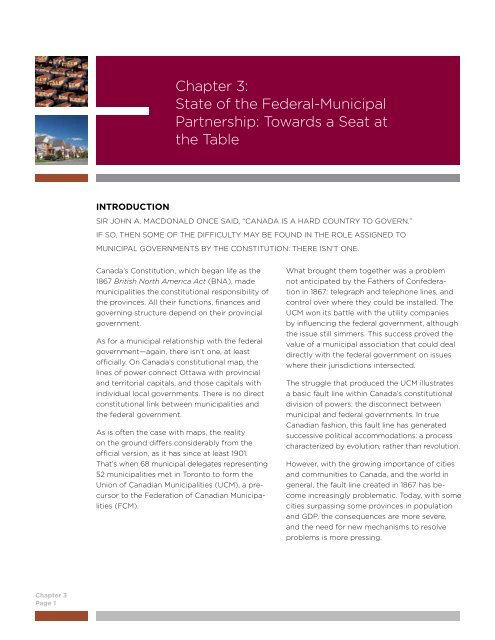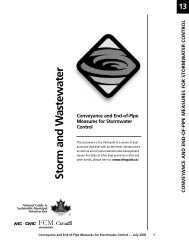The State of Canada's Cities and Communities 2012 - FCM
The State of Canada's Cities and Communities 2012 - FCM
The State of Canada's Cities and Communities 2012 - FCM
You also want an ePaper? Increase the reach of your titles
YUMPU automatically turns print PDFs into web optimized ePapers that Google loves.
Chapter 3<br />
Page 1<br />
INTRODUCTION<br />
Chapter 3:<br />
<strong>State</strong> <strong>of</strong> the Federal-Municipal<br />
Partnership: Towards a Seat at<br />
the Table<br />
SIR JOHN A. MACDONALD ONCE SAID, “CANADA IS A HARD COUNTRY TO GOVERN.”<br />
IF SO, THEN SOME OF THE DIFFICULTY MAY BE FOUND IN THE ROLE ASSIGNED TO<br />
MUNICIPAL GOVERNMENTS BY THE CONSTITUTION: THERE ISN’T ONE.<br />
Canada’s Constitution, which began life as the<br />
1867 British North America Act (BNA), made<br />
municipalities the constitutional responsibility <strong>of</strong><br />
the provinces. All their functions, finances <strong>and</strong><br />
governing structure depend on their provincial<br />
government.<br />
As for a municipal relationship with the federal<br />
government—again, there isn’t one, at least<br />
<strong>of</strong>ficially. On Canada’s constitutional map, the<br />
lines <strong>of</strong> power connect Ottawa with provincial<br />
<strong>and</strong> territorial capitals, <strong>and</strong> those capitals with<br />
individual local governments. <strong>The</strong>re is no direct<br />
constitutional link between municipalities <strong>and</strong><br />
the federal government.<br />
As is <strong>of</strong>ten the case with maps, the reality<br />
on the ground differs considerably from the<br />
<strong>of</strong>ficial version, as it has since at least 1901.<br />
That’s when 68 municipal delegates repre senting<br />
52 municipalities met in Toronto to form the<br />
Union <strong>of</strong> Canadian Municipalities (UCM), a precursor<br />
to the Federation <strong>of</strong> Canadian Municipalities<br />
(<strong>FCM</strong>).<br />
What brought them together was a problem<br />
not anticipated by the Fathers <strong>of</strong> Confederation<br />
in 1867: telegraph <strong>and</strong> telephone lines, <strong>and</strong><br />
control over where they could be installed. <strong>The</strong><br />
UCM won its battle with the utility companies<br />
by influencing the federal government, although<br />
the issue still simmers. This success proved the<br />
value <strong>of</strong> a municipal association that could deal<br />
directly with the federal government on issues<br />
where their jurisdictions intersected.<br />
<strong>The</strong> struggle that produced the UCM illustrates<br />
a basic fault line within Canada’s constitutional<br />
division <strong>of</strong> powers: the disconnect between<br />
municipal <strong>and</strong> federal governments. In true<br />
Canadian fashion, this fault line has generated<br />
successive political accommodations: a process<br />
characterized by evolution, rather than revolution.<br />
However, with the growing importance <strong>of</strong> cities<br />
<strong>and</strong> communities to Canada, <strong>and</strong> the world in<br />
general, the fault line created in 1867 has become<br />
increasingly problematic. Today, with some<br />
cities surpassing some provinces in population<br />
<strong>and</strong> GDP, the consequences are more severe,<br />
<strong>and</strong> the need for new mechanisms to resolve<br />
problems is more pressing.

















